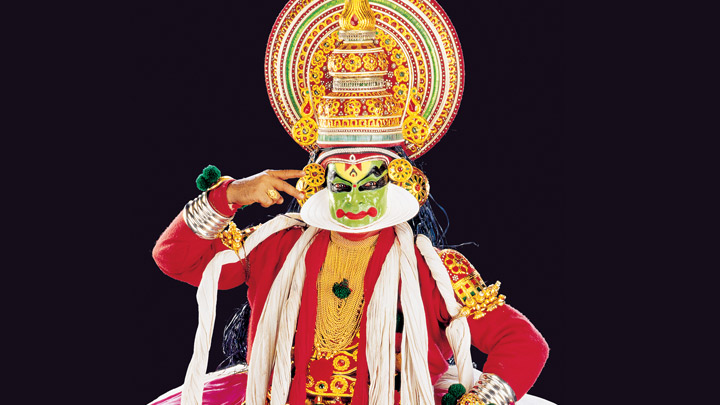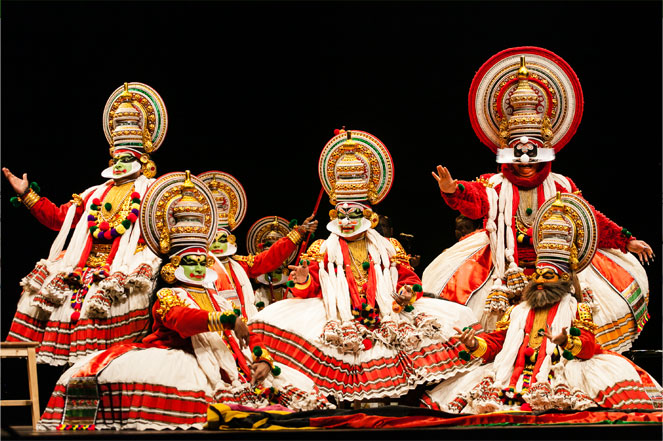- Home
- Culture of India
- Indian Dances
- Kathakali
Kathakali-traditional dance from Kerala
Updated: 13-03-24
Kathakali is a traditional dance-drama form that originated in the southern Indian state of Kerala. It is a highly stylized and elaborate art form that combines elements of dance, drama, music, and ritual. Kathakali is known for its vibrant costumes, intricate makeup, and powerful expressions.
This dance form originated from Kerala. Kathakali includes a mythological story being depicted through intense foot and hand movements and face expressions. Kathakali is a mixture of five forms of art they are Sahithyam(literature), Sangeetham (music) Natyam is acting, Nrthriyam is dance and Chitram is painting.
Kathakali had major influence from Krishnattam, Ramanattam, Koodiyattam and Chakiarkootu. Among the four the major were krishnattam and Ramanattam. In this Krishnattam is the dance drama form about Lord Krishna and Ramanattam was based on Lord Rama and Ramayana. Kathakali has various martial arts steps included.
Traditionally this dance was based on mythological stories of Ramayana, Mahabharata and about Lord Krishna but now in modern times it has included various other factors as well. Previously the character of women was done by male dancers himself but now women are included in this dance form.

History and Evolution
Kathakali, a classical dance-drama form, has a rich history and has evolved over several centuries. Its roots can be traced back to the traditional performing arts of southern India. The development and evolution of Kathakali can be understood through various historical and cultural influences. Traditionally the name of this dance form was deduced by joining two words, ‘Katha’ and ‘Kali’ where ‘Katha’ in Sanskrit means a traditional tale or story and ‘Kali’ derived from ‘Kala’ refers to art and performance.
Kathakali has its roots in the ancient text called Natya Shastra. It is a Sanskrit text on performing arts written by Baratha Muni. It consists of 6000 verses and over 36 chapters. It is presumed that the full version was first completed between 200 BCE to 200 CE but also varies from 500 BCE to 500 CE. The root of this wonderful dance is still not clear. Jones and Ryan believe that it is more than 500 years old and could have emerged during art performance in 16th and 17th century in Kerala.
Zarrilli also believes that Krishnattam which is the dance drama art form is a precursor of Kathakali. Krishnattam typically covers the life of Lord Krishna from his birth to his childhood exploits, his role in the Mahabharata, and his interactions with various characters. Each day of the performance focuses on a specific episode, making the entire presentation a comprehensive narrative of Krishna's life. Krishnattam is believed to have originated in the 17th century under the patronage of the Zamorin of Kozhikode, who was a devout devotee of Lord Guruvayurappan (Lord Krishna). According to legend, the Zamorin, Manavedan Namboodiri, a member of the Zamorin royal family, desired to create a performance that would narrate the stories of Lord Krishna. This desire led to the birth of Krishnattam.
Scholar Richmond also believes that there is similarity between Kathakali and Kutiyyatam. Kutiyattam is one of the oldest existing forms of theater in the world, originating from the state of Kerala in South India. Recognized by UNESCO as a Masterpiece of the Oral and Intangible Heritage of Humanity, Kutiyattam is a classical Sanskrit theater that combines elements of drama, dance, music, and ritual.
Repertoire of Kathakali dance
The repertoire of Kathakali includes various characters, themes, and sequences. Here are some key elements commonly found in the Kathakali repertoire:
- Attakathas (Scripts): Kathakali performances are based on traditional scripts known as "Attakathas." These scripts are written in Malayalam, the language of Kerala, and provide a detailed framework for the performance, including dialogues, descriptions of characters, and stage directions.
Kathakali often presents stories from the Indian epics, such as:
- Ramayana: Episodes involving Lord Rama, Sita, Hanuman, and other characters.
- Mahabharata: Stories related to the Pandavas, Kauravas, and Krishna, including the Bhagavad Gita.
- Puranas: Episodes from Hindu mythology and Puranic literature, portraying various deities and celestial beings.
- Kathakali incorporates a vast repertoire of hand gestures known as mudras. These gestures, combined with facial expressions, help convey complex emotions, actions, and dialogues.
- Kathakali performances are traditionally divided into specific times or phases, known as "Kalas." Each Kala represents a different aspect of the performance, helping to structure the narrative and maintain a dynamic rhythm. Traditionally the dance starts at dusk and is performed through dawn with breaks and interludes and sometimes for several nights starting at dusk.
- Padams (Songs): Kathakali features traditional songs known as "Padams" that are sung during the performance. These songs, often in Malayalam or Sanskrit, contribute to the storytelling and emotional depth of the characters.
Sequences in Kathakali dance
Kathakali dance usually starts evenings and
goes on till late night. It begins with a beat of drums making the audience to
be ready for the dance show. Kathakali is performed in seven sequences. They are.
Totayam performed behind the curtains without full Dressup.
Purupattu is performed after the opening of curtains with full costume.
Kalasam
Iratti
Tonkaram
Nalamiratti
The emotions and feelings in the dance are expressed through eyes and facial movements. Kathaklai has various mudras through which the dancers speak with the auidence. There are more than 500 plays written for kathakali . Some plays are interconnected. Some of the famous artists of kathakali are Kalamandalam Gopi, Kalamandalam Ramkutty Nair, Kottakal Sivaraman, Kalamandalam Kesavan Namboodiri and many more….
Costume worn by the dancers
Costume—Costume plays a vital role in kathakali. It depicts the character of the performing artist. Different colours are painted . each colour represents different character.
Sambhava (Headgear): The headgear worn by Kathakali dancers is called the "Sambhava." It is a large, intricate piece that extends upwards, creating a towering appearance. The design of the Sambhava may vary based on the character being portrayed. Face mask and headgear is added to show the intricate nature of the character.
The face is painted heavily with bright colours and with a huge head throne. The colours used on face are all natural colour made of rice flour and other natural ingredients.
The eyebrows are painted with black paint. The makeup done is of seven types—Pacha (green), Kathi (knife), Thadi (beard), Kari (black), Pazhuppu (silver), Teppu (white) and Minnuku (orange). Usually vegetable colours are used to paint faces. Each colour painted on each face indicate different characters.
The person who has painted green on face with red lipsticks portrays the character of Lord Krishna, Vishnu, Rama and Yudhistra. If red is painted it shows the character of evil persons like Ravvan, Dhushyasana and Hiranyakashipu. Minnuku represents women character like Sita, Panchali and Mohini. Teppu is for the characters of messengers like Jatayu, Hamsa and Garuda. Kari is for hunters and forest people. Costume plays a very important role in Kathakali to understand the dance for the audience.
There are three gunas known as sattva(goodness), rajas(passion) and tamas(darkness) which are portrayed in the dance and these characters are present in all the human beings. Along with this heavy make up the artists also use jewelries to suit different characters.
The costume, or "Vesham," includes the garments worn by the dancer. The attire is often a colorful and heavily decorated skirt, with the color and design varying depending on the character. Kathakali dancers wear trousers known as "Karakachira," which are usually black or dark-colored and are visible below the skirt. The trousers allow for ease of movement during the intricate footwork.
Instruments and music
Instruments and music: Music sets a very vital role in Kathakali as it shows the emotions of the dancers and of the particular scene in the dance. If anger is shown by the dancer then the voice of the singer becomes loud and sharp where as when the voice of the singer is low and requesting then it means sad scene is being depicted. Various instruments are used in Kathakali some of them are Maddalam, Centa and Ityakka are three drums.
The performers are mum while performing the dancers do not utter a word. They express only through mudras and hand gestures. The song is sung by the vocalist from behind. The singing is quite different in kathakali and it is called as sopaanam generally sung by two singers. Major musical patterns that are used are Chempata that is used to show different moods, Campa for tension, Pancari during sharpening of sword, triputa includes teachers or sages preachings, Atanta about kings or divine and Muri Atanta for comic scenes.
Update on coronavirus in India
Affiliate Disclosure:
If you make any purchase via a link on this site, I may receive a small commission with no added cost to you.



